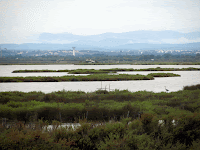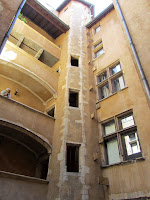Not at all what we expected - in the south of France! The canal was absolutely frozen for a couple of weeks - strong enought to walk on by all accounts, although we didn't try our luck on that.
 |
| Snow covered ice on the canal. |
Friends in barges just behind us found themselves at quite an uncomfortable angle and had to resort to propping up bed legs and table legs to maintain reasonably horizontal. I imagine cooking was quite a challenge - things skittering off work surfaces without warning.
Soon enough we were back to normal, and even managed to have a few out door coffee sessions and the occasional barbeque in the warm sunshine of early spring.
 We have – almost by accident – acquired a “stationnement’
at Caumont sur Garonne, where we headed originally. (Parked up behind our
friends Charles and Caroline - originally from the Canadian yacht Itza Purla and
who now live on the barge Connie).
We have – almost by accident – acquired a “stationnement’
at Caumont sur Garonne, where we headed originally. (Parked up behind our
friends Charles and Caroline - originally from the Canadian yacht Itza Purla and
who now live on the barge Connie).
The VNF (Voies navigables de France) who manage
and maintain the canals in France decided that all canal users ought to be tracked. (Or possibly realised somewhat belatedly that all the boats that use the canal are a source of revenue. Somebody has to pay for all those trees that have to destroyed and canal banks that have to be replanted.) They came armed with cameras and GPS to take note of who we are and where we were and how long we stayed in one spot.
Soon we were told we had to move on barges and boats could stay in one place only for 30 days, otherwise they have move 10 meters. Which is usually perfectly OK – except if one gets lazy and wants to stay put. Or if one wants to continue the ongoing work on the boat – as we did, well, as we still do; it is definately more convenient to stay put in the same place, especially as we have a source of electricity and water nearby.
We duly applied for a temporary
“stationement” (cutting a long story much shorter) hoping we could stay in our
customary place for another three months. When the contract (in triplicate – and
in French - who said we’d have a paperless world?) finally arrived several
months later - we discovered the authorities (VNF) had awarded us a contract for
five years (with a very modest yearly fee).
So now we have a base home from home.
When we wish to move on, we can still untie the lines, fire up the engine and make way, but we are legal on the canal; we also understand that this is also acceptable by our insurance, should we wish to winter over in the same place.
Soon we were told we had to move on barges and boats could stay in one place only for 30 days, otherwise they have move 10 meters. Which is usually perfectly OK – except if one gets lazy and wants to stay put. Or if one wants to continue the ongoing work on the boat – as we did, well, as we still do; it is definately more convenient to stay put in the same place, especially as we have a source of electricity and water nearby.
 |
| Sara, Caitlyn and Breanne, Portugal |
So now we have a base home from home.
When we wish to move on, we can still untie the lines, fire up the engine and make way, but we are legal on the canal; we also understand that this is also acceptable by our insurance, should we wish to winter over in the same place.
We had some splendid times over the summer.
My daughter whisked us off on a fabulous holiday in Portugal, where we enjoyed sun, sand and sea together with two of my grandchildren. We wangled a few sailing days between the northern Mediterranean coast of Spain and the fabled island of Corsica with Charles and Caroline on Itza Purla, and even had time to explore some of the mountains and hillside villages on the southern end of that island.
 |
| Sap from fir trees |
Assorted friends and relatives came to visit us
over the months, enjoying, we hope, the local wines along with gourmet treats of
delicious breads and cheeses, fois gras, cassoulet and duck, to name a few;
finally cruising friends flew in to assist us on the uphill battle with the
locks on our way past Toulouse to this, our winter port on the Canal du Midi,
in Cathar country.
Fiona and Chris came to visit last year on the Midi - this year it is all uphill again - just a different canal!
Fiona and Chris came to visit last year on the Midi - this year it is all uphill again - just a different canal!
 |
| Portugese castle |
There is an abundance of foie gras, specialty cheeses including goats cheese, local yogurt, honey, preserves, olive oils, chutneys, locally grown prunes and olives bursting with flavour.
There are white breads and brown breads, both paysanne and baguette; wines abound – red, white, rose and sparking, in bottles, jugs and boxes, together with Cognac and Armagnac. All manner of fowl (duck and goose being especially popular in the winter season) on display, side by side with vans or stalls offering the juiciest selections of pork, veal and beef (lets ignore the horse and rabbit) and often one can see locally hunted venison, together with sausages, mussels, oysters, fabulous paellas and selections of fish. Pies, pates, chocolates, coffee, teas and flavoured chocolate drinks - the list seems endless.
 |
| Cork from a cork tree |
In the summer months we can meet with friends several times a week
in one or another nearby village square to enjoy a night market, squeezing into a place on a bench or chair at the long tables set up by the local Marie.
Various vendors sell food – with choices ranging from mussels, pizza, paella,
salads, fries, duck, beef and sizzling pork - with varieties of cheeses, ice
creams, strawberries, or fruit bowls to follow. Local vineyards sell their
wines, by the bottle or by the glass (a bottle of water can cost nearly as
much) and small cups of that strong coffee so beloved by the French are
available.
 Local musicians and bands arrive with their equipment to entertain (some better
than others) and as the night wears on most of us manage to strut our stuff on
the dance floor. The French still do ‘tea dances’ – and love to practice their
fancy footwork - so often a pleasure to watch. Small children accompany their
parents and grandparents, and groups of teenagers may be seen joining the
dancing later in the evenings – all comers well behaved and all appearing to
have fun.
Local musicians and bands arrive with their equipment to entertain (some better
than others) and as the night wears on most of us manage to strut our stuff on
the dance floor. The French still do ‘tea dances’ – and love to practice their
fancy footwork - so often a pleasure to watch. Small children accompany their
parents and grandparents, and groups of teenagers may be seen joining the
dancing later in the evenings – all comers well behaved and all appearing to
have fun.
 |
| Live chickens and pidgeons at market |
 Local musicians and bands arrive with their equipment to entertain (some better
than others) and as the night wears on most of us manage to strut our stuff on
the dance floor. The French still do ‘tea dances’ – and love to practice their
fancy footwork - so often a pleasure to watch. Small children accompany their
parents and grandparents, and groups of teenagers may be seen joining the
dancing later in the evenings – all comers well behaved and all appearing to
have fun.
Local musicians and bands arrive with their equipment to entertain (some better
than others) and as the night wears on most of us manage to strut our stuff on
the dance floor. The French still do ‘tea dances’ – and love to practice their
fancy footwork - so often a pleasure to watch. Small children accompany their
parents and grandparents, and groups of teenagers may be seen joining the
dancing later in the evenings – all comers well behaved and all appearing to
have fun.
Vide Grenier are also a common attraction and the
one held in our village is especially good. The term, loosely
translated means 'empty your attic'. In Caumont the single road through the village (there is after all only one shop in the village it is so small,) is
blocked off in the early hours of a summer morning, ensuring vendors adequate
space to set up their wide ranging variety of tables and stalls. Parking
thereafter is at a premium and one may have to walk over a kilometre or even
from the next village to get to the scene of excitement.
Who said one man's
trash is another man's treasure? Well - here you may have it - whatever you want. Shoes, jewellery,
crockery, books and furniture jostle with toys, house wares, tools, linens, the
overflowing tables lining both sides of the street.
In the bright sunshine deals are struck and happy, smiling customers carry away their booty. At the end of the day children struggle with armloads of toys; baby carriages overflowing with clothes are pushed away; school desks and chairs are lugged off by sweating dads; wine racks and tools, teapots and towels find new homes. Contented stall owners pack up in the waning light, and by the next morning the village has returned to it's normal sleepy routine.
 |
| Barges in Portugal |
In the bright sunshine deals are struck and happy, smiling customers carry away their booty. At the end of the day children struggle with armloads of toys; baby carriages overflowing with clothes are pushed away; school desks and chairs are lugged off by sweating dads; wine racks and tools, teapots and towels find new homes. Contented stall owners pack up in the waning light, and by the next morning the village has returned to it's normal sleepy routine.
 |
| Wild pigs roam Corsican mountains |
The galley is functional with a new cooker and a household fridge freezer, a tiled shower has been installed, and a washing machine arrived to take up space in the head. Mike continues to work his magic with electrical fittings and water hoses. New cupboards line the walls, fresh paint adorns the bedroom, and still we have plans for more.
 |
| Mountain village, Corsica |
 |
| Molly and Doug came to visit |
It will be very sad to see the changes as time progresses, and other less attractive trees spread along the canals.



























































